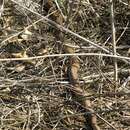en
names in breadcrumbs


This species can grow to be one of the largest snakes in the United States. It is a very active animal, and does not do well in captivity. The Coachwhip derived its name in part to the appearance of its tapered tail which is similar to that of a braided whip. In popular folklore, the Coachwhip was thought to wrap itself around a person and lash out with its tail, administering powerful beating whiplike movements. Following these actions it would place the edge of its tail into the nose of the victim to differentiate whether it was still breathing. There is no evidence to support these beliefs. However, the Coachwhip is known to be a very nervous snake, and will attack repeatedly if cornered.
One subspecies, the San Joaquin whipsnake (Masticophis flagellum ruddocki) has been listed by the California Department of Fish and Game as a "Species of Special Concern" (California Dept. of Fish and Game 2001)
IUCN Red List of Threatened Species: least concern
These are active, aggressive snakes, and will bite if handled. They are not venomous.
Coachwhips include pest rodents and venomous snakes in their diet.
Preys on birds, rodents, lizards, other snakes(including rattlesnakes), small turtles, bird eggs, and insects. It hunts with its head raised above the ground, and will eat several small rodents during one feeding. It feeds approximately every five days. (Barker 1964)
Masticophis flagellum is found is found in the southern half of the U.S., and the northern 2/3rds of Mexico (King 1979).
Biogeographic Regions: nearctic (Native )
Open hillsides, dry sand, prairies, oak and pine woodlands, grassy areas, dunes, and scrub. Not found above 2150m altitude (King 1979, Stebbins 1985)
Terrestrial Biomes: desert or dune ; savanna or grassland ; chaparral ; forest
Average lifespan
Status: captivity: 20.2 years.
This is a long, slender snake with smooth scales. The dorsal coloration in the adult varies from shades of tan, grey, pink, and red. Thin, white crossbars or blotches are found on the dorsal area behind the black or brown neck. The ventral surface is usually a tan to pinkish. Juveniles have tan, brown, or black transverse bands. In hatchlings the black neck is absent. The adult length ranges from 91.4-259 cm. The large eyes have round pupils, and are protected by supraocular scales. It has 17 dorsal scale rows at midbody, and a divided anal plate.(King 1979)
In the U.S. M. flagellum reproduces once per year. Mating occurs in the spring, and females lay a clutch of 4-16 eggs in June or July. The young hatch from the granular-surfaced eggs in 6-11 weeks. Hatchlings are 30-40 cm long (King 1979, Stebbins 1985).